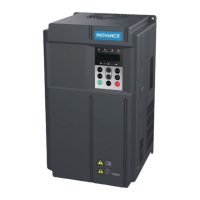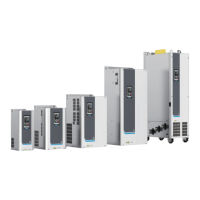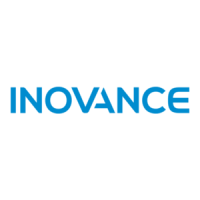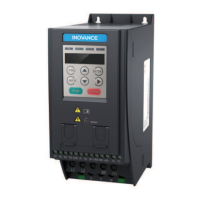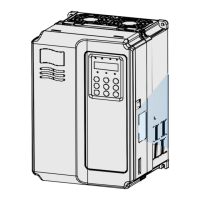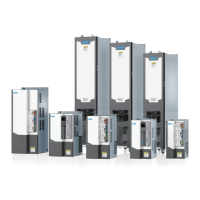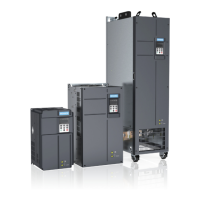Do you have a question about the Inovance MD500-PLUS Series and is the answer not in the manual?
Details changes made across different versions of the guide.
Information on how to obtain the PDF version of the guide.
Comprehensive list of all function parameters with their details.
List of parameters used for monitoring the AC drive's status and performance.
Contains fundamental parameters for basic AC drive configuration and operation.
Parameters specific to configuring the motor connected to the AC drive.
Parameters for advanced vector control of the motor.
Parameters for V/f control method, including curve settings.
Configuration for digital and analog input terminals and their functions.
Configuration for digital and analog output terminals and their functions.
Parameters related to starting, stopping, and braking the motor.
Configuration of the operating panel keys and display functions.
Parameters for various auxiliary functions of the AC drive.
Settings for various fault detection and protection mechanisms.
Parameters for PID control loop configuration and tuning.
Parameters for specialized functions like wobble, fixed length, and counting.
Parameters for multi-reference frequency sources and simple PLC functionality.
Settings for communication protocols and parameters.
Parameters that can be customized by the user.
Parameters related to user password and initialization.
Parameters for torque control and setting limits.
Configuration of virtual digital input and output terminals.
Parameters for optimizing drive performance and tuning.
Parameters for defining analog input curves for frequency reference.
Additional parameters for advanced vector control.
Parameters for tension control modes, linear speed, and roll diameter calculation.
Parameters for configuring and managing tension control settings.
Parameters for taper curve generation during winding.
Parameters for configuring communication mappings freely.
Parameters for monitoring basic AC drive status and values.
Parameters for monitoring tension control specific values.
Settings for basic drive configuration, including command sources.
How to select sources for start, stop, and jog commands.
Methods for setting the main frequency reference for the AC drive.
Options for selecting the main frequency source, including digital and analog inputs.
Configuring multiple frequency references using DI terminals.
Using a simple PLC for frequency control.
Selecting sources for auxiliary frequency reference.
Setting upper and lower limits for frequency references.
Configuring pulse input as the main frequency source.
Setting acceleration and deceleration times for motor start/stop.
Settings for configuring motor parameters and auto-tuning.
Process for automatically tuning asynchronous motor parameters.
Process for automatically tuning synchronous motor parameters.
Configuration and functions of DI (Digital Input) terminals.
Mapping functions to digital input terminals.
Mapping functions to digital output terminals.
Configuration of virtual digital input terminals.
Configuration of analog input terminals and their use as digital inputs.
Parameters affecting motor control performance and tuning.
Configuring V/f curves for voltage-frequency relationship.
Setting limits for output current to protect the motor.
Parameters to prevent overvoltage during stall conditions.
Tuning parameters for the speed control loop.
Adjusting slip for better performance in vector control.
Setting limits for torque output.
Tuning parameters for the current control loop.
Optimizing drive performance in field-weakening mode.
Improving performance in FVC mode.
Parameters for auxiliary control functions like PWM modulation.
Settings for processing encoder signals for feedback.
Parameters for synchronous motor control in PMVVC mode.
Functionality for creating frequency wobbling.
Function for controlling length based on pulses.
Function for collecting count values from DI terminals.
How to configure the drive for specific application control scenarios.
Configuration for jog running mode, used for testing.
Setting thresholds and hysteresis for output frequency detection.
Disabling reverse frequency operation.
Selecting acceleration/deceleration times based on running frequency.
Detecting output current levels.
Setting transition time for direction changes.
Setting timers for various operations.
Parameters and modes for controlling material tension.
Choosing the appropriate tension control mode.
Torque control without feedback for tension.
Torque control with feedback for precise tension.
Speed control with feedback for tension.
Methods for calculating roll diameter.
Parameters related to linear speed control.
Mode for maintaining a constant linear speed.
Limitations and requirements for tension control modes.
Setting the target tension and related parameters.
Tuning PID parameters for closed-loop control.
Compensating torque for tension control.
Function for automatic reel replacement.
Parameters for taper curve generation during winding.
Protection mechanisms during motor startup.
Protection against voltage and current limits.
Protection against input phase loss.
Protection against motor and drive overtemperature.
Protection against motor overload conditions.
Protection against load loss.
Protection against excessive motor speed.
Protection against significant speed deviations.
Functionality to maintain operation during power dips.
Procedures for resetting faults.
Defining actions to take upon specific faults.
Detection of ground faults.
Setting and managing frequently used parameters.
Configuring sleep and wakeup modes for energy saving.
Setting thresholds for current running time.
Understanding how parameters are addressed for communication.
Overview of communication protocols and data classification.
Details on Modbus RTU communication protocol.
Structure of Modbus-RTU data frames.
Rules for expressing parameter addresses in communication.
Specific communication parameters for Group Fd.
Comprehensive list of fault codes, possible causes, and actions.
Details changes made across different versions of the guide.
Information on how to obtain the PDF version of the guide.
Comprehensive list of all function parameters with their details.
List of parameters used for monitoring the AC drive's status and performance.
Contains fundamental parameters for basic AC drive configuration and operation.
Parameters specific to configuring the motor connected to the AC drive.
Parameters for advanced vector control of the motor.
Parameters for V/f control method, including curve settings.
Configuration for digital and analog input terminals and their functions.
Configuration for digital and analog output terminals and their functions.
Parameters related to starting, stopping, and braking the motor.
Configuration of the operating panel keys and display functions.
Parameters for various auxiliary functions of the AC drive.
Settings for various fault detection and protection mechanisms.
Parameters for PID control loop configuration and tuning.
Parameters for specialized functions like wobble, fixed length, and counting.
Parameters for multi-reference frequency sources and simple PLC functionality.
Settings for communication protocols and parameters.
Parameters that can be customized by the user.
Parameters related to user password and initialization.
Parameters for torque control and setting limits.
Configuration of virtual digital input and output terminals.
Parameters for optimizing drive performance and tuning.
Parameters for defining analog input curves for frequency reference.
Additional parameters for advanced vector control.
Parameters for tension control modes, linear speed, and roll diameter calculation.
Parameters for configuring and managing tension control settings.
Parameters for taper curve generation during winding.
Parameters for configuring communication mappings freely.
Parameters for monitoring basic AC drive status and values.
Parameters for monitoring tension control specific values.
Settings for basic drive configuration, including command sources.
How to select sources for start, stop, and jog commands.
Methods for setting the main frequency reference for the AC drive.
Options for selecting the main frequency source, including digital and analog inputs.
Configuring multiple frequency references using DI terminals.
Using a simple PLC for frequency control.
Selecting sources for auxiliary frequency reference.
Setting upper and lower limits for frequency references.
Configuring pulse input as the main frequency source.
Setting acceleration and deceleration times for motor start/stop.
Settings for configuring motor parameters and auto-tuning.
Process for automatically tuning asynchronous motor parameters.
Process for automatically tuning synchronous motor parameters.
Configuration and functions of DI (Digital Input) terminals.
Mapping functions to digital input terminals.
Mapping functions to digital output terminals.
Configuration of virtual digital input terminals.
Configuration of analog input terminals and their use as digital inputs.
Parameters affecting motor control performance and tuning.
Configuring V/f curves for voltage-frequency relationship.
Setting limits for output current to protect the motor.
Parameters to prevent overvoltage during stall conditions.
Tuning parameters for the speed control loop.
Adjusting slip for better performance in vector control.
Setting limits for torque output.
Tuning parameters for the current control loop.
Optimizing drive performance in field-weakening mode.
Improving performance in FVC mode.
Parameters for auxiliary control functions like PWM modulation.
Settings for processing encoder signals for feedback.
Parameters for synchronous motor control in PMVVC mode.
Functionality for creating frequency wobbling.
Function for controlling length based on pulses.
Function for collecting count values from DI terminals.
How to configure the drive for specific application control scenarios.
Configuration for jog running mode, used for testing.
Setting thresholds and hysteresis for output frequency detection.
Disabling reverse frequency operation.
Selecting acceleration/deceleration times based on running frequency.
Detecting output current levels.
Setting transition time for direction changes.
Setting timers for various operations.
Parameters and modes for controlling material tension.
Choosing the appropriate tension control mode.
Torque control without feedback for tension.
Torque control with feedback for precise tension.
Speed control with feedback for tension.
Methods for calculating roll diameter.
Parameters related to linear speed control.
Mode for maintaining a constant linear speed.
Limitations and requirements for tension control modes.
Setting the target tension and related parameters.
Tuning PID parameters for closed-loop control.
Compensating torque for tension control.
Function for automatic reel replacement.
Parameters for taper curve generation during winding.
Protection mechanisms during motor startup.
Protection against voltage and current limits.
Protection against input phase loss.
Protection against motor and drive overtemperature.
Protection against motor overload conditions.
Protection against load loss.
Protection against excessive motor speed.
Protection against significant speed deviations.
Functionality to maintain operation during power dips.
Procedures for resetting faults.
Defining actions to take upon specific faults.
Detection of ground faults.
Setting and managing frequently used parameters.
Configuring sleep and wakeup modes for energy saving.
Setting thresholds for current running time.
Understanding how parameters are addressed for communication.
Overview of communication protocols and data classification.
Details on Modbus RTU communication protocol.
Structure of Modbus-RTU data frames.
Rules for expressing parameter addresses in communication.
Specific communication parameters for Group Fd.
Comprehensive list of fault codes, possible causes, and actions.
